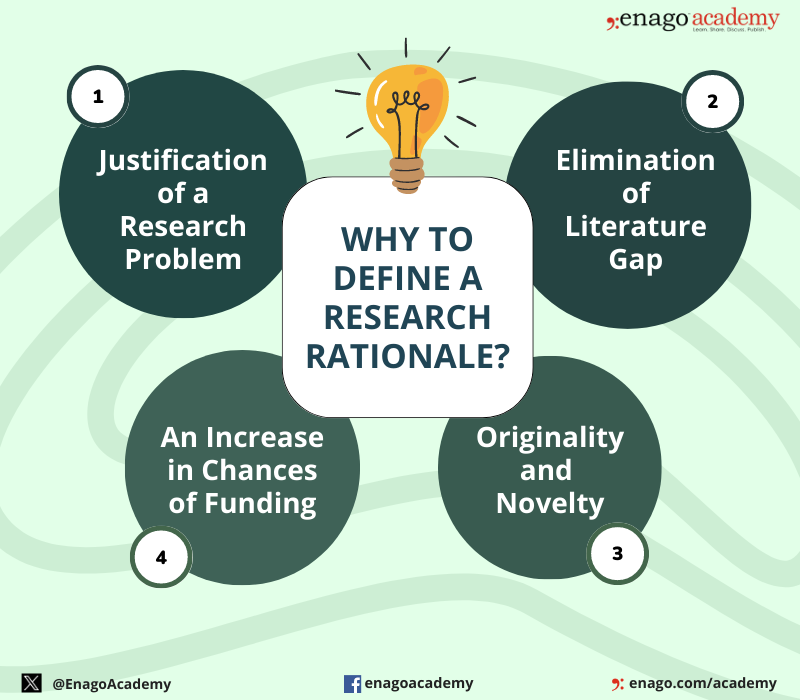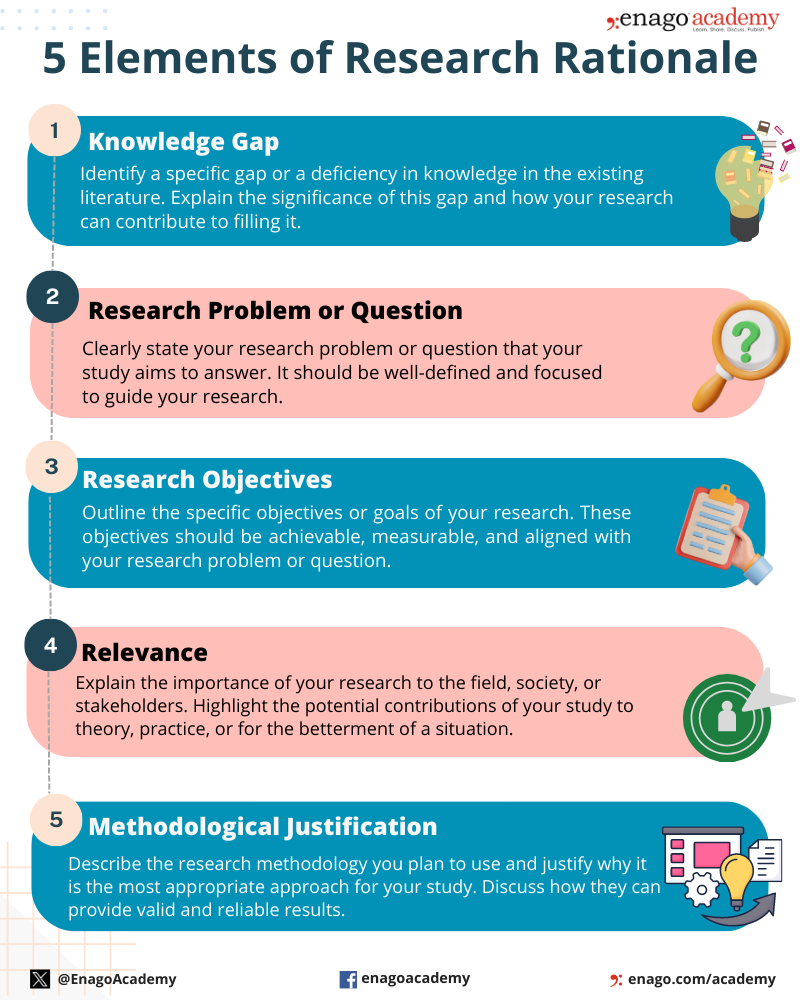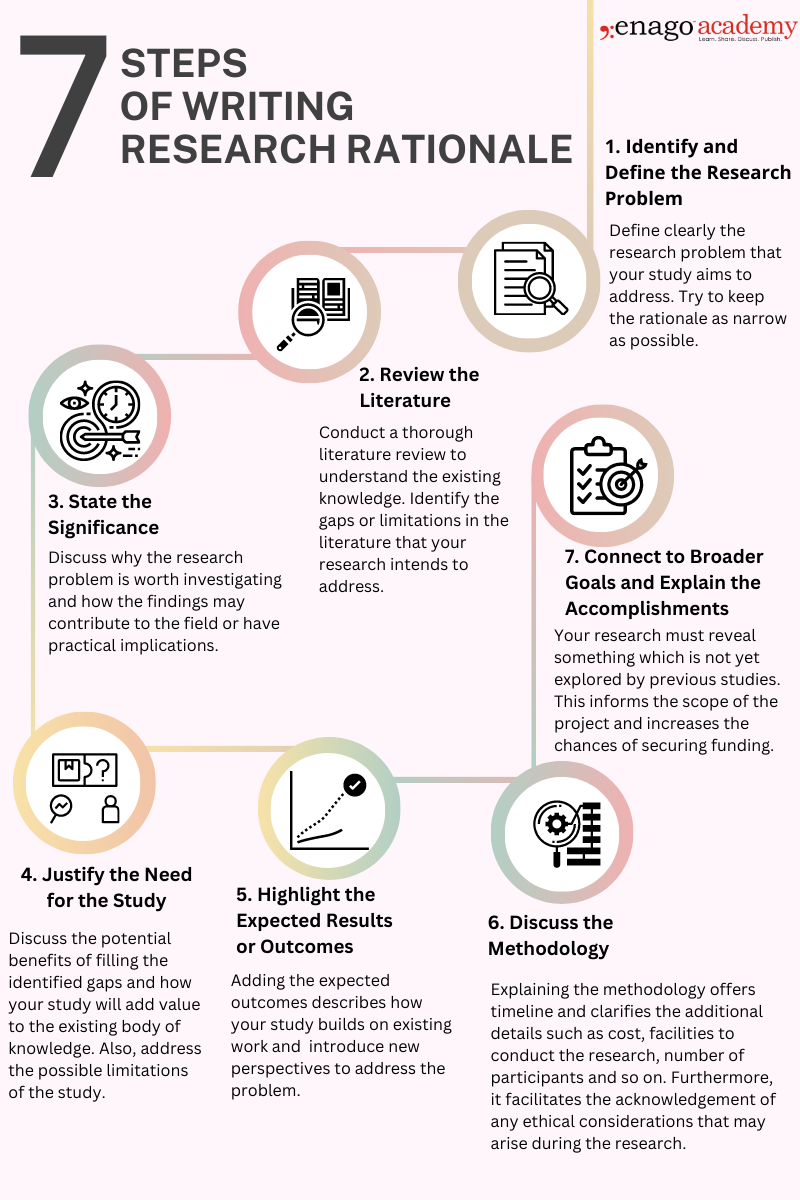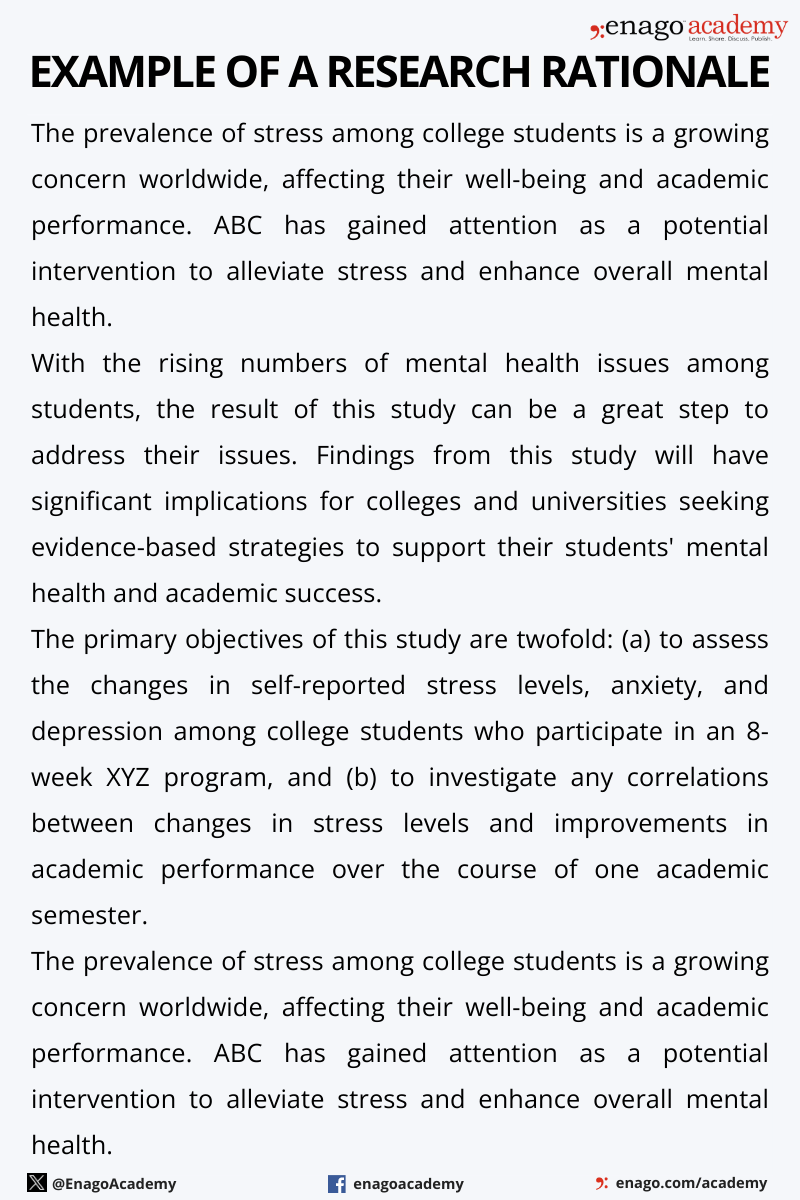How to Write the Rationale for a Research Paper
- Research Process
- Peer Review
A research rationale answers the big SO WHAT? that every adviser, peer reviewer, and editor has in mind when they critique your work. A compelling research rationale increases the chances of your paper being published or your grant proposal being funded. In this article, we look at the purpose of a research rationale, its components and key characteristics, and how to create an effective research rationale.
Updated on September 19, 2022

The rationale for your research is the reason why you decided to conduct the study in the first place. The motivation for asking the question. The knowledge gap. This is often the most significant part of your publication. It justifies the study's purpose, novelty, and significance for science or society. It's a critical part of standard research articles as well as funding proposals.
Essentially, the research rationale answers the big SO WHAT? that every (good) adviser, peer reviewer, and editor has in mind when they critique your work.
A compelling research rationale increases the chances of your paper being published or your grant proposal being funded. In this article, we look at:
- the purpose of a research rationale
- its components and key characteristics
- how to create an effective research rationale

What is a research rationale?
Think of a research rationale as a set of reasons that explain why a study is necessary and important based on its background. It's also known as the justification of the study, rationale, or thesis statement.
Essentially, you want to convince your reader that you're not reciting what other people have already said and that your opinion hasn't appeared out of thin air. You've done the background reading and identified a knowledge gap that this rationale now explains.
A research rationale is usually written toward the end of the introduction. You'll see this section clearly in high-impact-factor international journals like Nature and Science. At the end of the introduction there's always a phrase that begins with something like, "here we show..." or "in this paper we show..." This text is part of a logical sequence of information, typically (but not necessarily) provided in this order:

Here's an example from a study by Cataldo et al. (2021) on the impact of social media on teenagers' lives.

Note how the research background, gap, rationale, and objectives logically blend into each other.
The authors chose to put the research aims before the rationale. This is not a problem though. They still achieve a logical sequence. This helps the reader follow their thinking and convinces them about their research's foundation.
Elements of a research rationale
We saw that the research rationale follows logically from the research background and literature review/observation and leads into your study's aims and objectives.
This might sound somewhat abstract. A helpful way to formulate a research rationale is to answer the question, “Why is this study necessary and important?”
Generally, that something has never been done before should not be your only motivation. Use it only If you can give the reader valid evidence why we should learn more about this specific phenomenon.
A well-written introduction covers three key elements:
- What's the background to the research?
- What has been done before (information relevant to this particular study, but NOT a literature review)?
- Research rationale
Now, let's see how you might answer the question.
1. This study complements scientific knowledge and understanding
Discuss the shortcomings of previous studies and explain how'll correct them. Your short review can identify:
- Methodological limitations . The methodology (research design, research approach or sampling) employed in previous works is somewhat flawed.
Example : Here , the authors claim that previous studies have failed to explore the role of apathy “as a predictor of functional decline in healthy older adults” (Burhan et al., 2021). At the same time, we know a lot about other age-related neuropsychiatric disorders, like depression.
Their study is necessary, then, “to increase our understanding of the cognitive, clinical, and neural correlates of apathy and deconstruct its underlying mechanisms.” (Burhan et al., 2021).
- Contextual limitations . External factors have changed and this has minimized or removed the relevance of previous research.
Example : You want to do an empirical study to evaluate the effects of the COVID-19 pandemic on the number of tourists visiting Sicily. Previous studies might have measured tourism determinants in Sicily, but they preceded COVID-19.
- Conceptual limitations . Previous studies are too bound to a specific ideology or a theoretical framework.
Example : The work of English novelist E. M. Forster has been extensively researched for its social, political, and aesthetic dimensions. After the 1990s, younger scholars wanted to read his novels as an example of gay fiction. They justified the need to do so based on previous studies' reliance on homophobic ideology.
This kind of rationale is most common in basic/theoretical research.
2. This study can help solve a specific problem
Here, you base your rationale on a process that has a problem or is not satisfactory.
For example, patients complain about low-quality hospital care on weekends (staff shortages, inadequate attention, etc.). No one has looked into this (there is a lack of data). So, you explore if the reported problems are true and what can be done to address them. This is a knowledge gap.
Or you set out to explore a specific practice. You might want to study the pros and cons of several entry strategies into the Japanese food market.
It's vital to explain the problem in detail and stress the practical benefits of its solution. In the first example, the practical implications are recommendations to improve healthcare provision.
In the second example, the impact of your research is to inform the decision-making of businesses wanting to enter the Japanese food market.
This kind of rationale is more common in applied/practical research.
3. You're the best person to conduct this study
It's a bonus if you can show that you're uniquely positioned to deliver this study, especially if you're writing a funding proposal .
For an anthropologist wanting to explore gender norms in Ethiopia, this could be that they speak Amharic (Ethiopia's official language) and have already lived in the country for a few years (ethnographic experience).
Or if you want to conduct an interdisciplinary research project, consider partnering up with collaborators whose expertise complements your own. Scientists from different fields might bring different skills and a fresh perspective or have access to the latest tech and equipment. Teaming up with reputable collaborators justifies the need for a study by increasing its credibility and likely impact.
When is the research rationale written?
You can write your research rationale before, or after, conducting the study.
In the first case, when you might have a new research idea, and you're applying for funding to implement it.
Or you're preparing a call for papers for a journal special issue or a conference. Here , for instance, the authors seek to collect studies on the impact of apathy on age-related neuropsychiatric disorders.
In the second case, you have completed the study and are writing a research paper for publication. Looking back, you explain why you did the study in question and how it worked out.
Although the research rationale is part of the introduction, it's best to write it at the end. Stand back from your study and look at it in the big picture. At this point, it's easier to convince your reader why your study was both necessary and important.
How long should a research rationale be?
The length of the research rationale is not fixed. Ideally, this will be determined by the guidelines (of your journal, sponsor etc.).
The prestigious journal Nature , for instance, calls for articles to be no more than 6 or 8 pages, depending on the content. The introduction should be around 200 words, and, as mentioned, two to three sentences serve as a brief account of the background and rationale of the study, and come at the end of the introduction.
If you're not provided guidelines, consider these factors:
- Research document : In a thesis or book-length study, the research rationale will be longer than in a journal article. For example, the background and rationale of this book exploring the collective memory of World War I cover more than ten pages.
- Research question : Research into a new sub-field may call for a longer or more detailed justification than a study that plugs a gap in literature.
Which verb tenses to use in the research rationale?
It's best to use the present tense. Though in a research proposal, the research rationale is likely written in the future tense, as you're describing the intended or expected outcomes of the research project (the gaps it will fill, the problems it will solve).
Example of a research rationale
Research question : What are the teachers' perceptions of how a sense of European identity is developed and what underlies such perceptions?

Braun, V., & Clarke, V. (2006). Using thematic analysis in psychology. Qualitative Research in Psychology , 3(2), 77-101.
Burhan, A.M., Yang, J., & Inagawa, T. (2021). Impact of apathy on aging and age-related neuropsychiatric disorders. Research Topic. Frontiers in Psychiatry
Cataldo, I., Lepri, B., Neoh, M. J. Y., & Esposito, G. (2021). Social media usage and development of psychiatric disorders in childhood and adolescence: A review. Frontiers in Psychiatry , 11.
CiCe Jean Monnet Network (2017). Guidelines for citizenship education in school: Identities and European citizenship children's identity and citizenship in Europe.
Cohen, l, Manion, L., & Morrison, K. (2018). Research methods in education . Eighth edition. London: Routledge.
de Prat, R. C. (2013). Euroscepticism, Europhobia and Eurocriticism: The radical parties of the right and left “vis-à-vis” the European Union P.I.E-Peter Lang S.A., Éditions Scientifiques Internationales.
European Commission. (2017). Eurydice Brief: Citizenship education at school in Europe.
Polyakova, A., & Fligstein, N. (2016). Is European integration causing Europe to become more nationalist? Evidence from the 2007–9 financial crisis. Journal of European Public Policy , 23(1), 60-83.
Winter, J. (2014). Sites of Memory, Sites of Mourning: The Great War in European Cultural History . Cambridge: Cambridge University Press.

The AJE Team
See our "Privacy Policy"
Ensure your structure and ideas are consistent and clearly communicated
Pair your Premium Editing with our add-on service Presubmission Review for an overall assessment of your manuscript.

Setting Rationale in Research: Cracking the code for excelling at research
Knowledge and curiosity lays the foundation of scientific progress. The quest for knowledge has always been a timeless endeavor. Scholars seek reasons to explain the phenomena they observe, paving way for development of research. Every investigation should offer clarity and a well-defined rationale in research is a cornerstone upon which the entire study can be built.
Research rationale is the heartbeat of every academic pursuit as it guides the researchers to unlock the untouched areas of their field. Additionally, it illuminates the gaps in the existing knowledge, and identifies the potential contributions that the study aims to make.
Table of Contents
What Is Research Rationale and When Is It Written
Research rationale is the “why” behind every academic research. It not only frames the study but also outlines its objectives , questions, and expected outcomes. Additionally, it helps to identify the potential limitations of the study . It serves as a lighthouse for researchers that guides through data collection and analysis, ensuring their efforts remain focused and purposeful. Typically, a rationale is written at the beginning of the research proposal or research paper . It is an essential component of the introduction section and provides the foundation for the entire study. Furthermore, it provides a clear understanding of the purpose and significance of the research to the readers before delving into the specific details of the study. In some cases, the rationale is written before the methodology, data analysis, and other sections. Also, it serves as the justification for the research, and how it contributes to the field. Defining a research rationale can help a researcher in following ways:

1. Justification of a Research Problem
- Research rationale helps to understand the essence of a research problem.
- It designs the right approach to solve a problem. This aspect is particularly important for applied research, where the outcomes can have real-world relevance and impact.
- Also, it explains why the study is worth conducting and why resources should be allocated to pursue it.
- Additionally, it guides a researcher to highlight the benefits and implications of a strategy.
2. Elimination of Literature Gap
- Research rationale helps to ideate new topics which are less addressed.
- Additionally, it offers fresh perspectives on existing research and discusses the shortcomings in previous studies.
- It shows that your study aims to contribute to filling these gaps and advancing the field’s understanding.
3. Originality and Novelty
- The rationale highlights the unique aspects of your research and how it differs from previous studies.
- Furthermore, it explains why your research adds something new to the field and how it expands upon existing knowledge.
- It highlights how your findings might contribute to a better understanding of a particular issue or problem and potentially lead to positive changes.
- Besides these benefits, it provides a personal motivation to the researchers. In some cases, researchers might have personal experiences or interests that drive their desire to investigate a particular topic.
4. An Increase in Chances of Funding
- It is essential to convince funding agencies , supervisors, or reviewers, that a research is worth pursuing.
- Therefore, a good rationale can get your research approved for funding and increases your chances of getting published in journals; as it addresses the potential knowledge gap in existing research.
Overall, research rationale is essential for providing a clear and convincing argument for the value and importance of your research study, setting the stage for the rest of the research proposal or manuscript. Furthermore, it helps establish the context for your work and enables others to understand the purpose and potential impact of your research.
5 Key Elements of a Research Rationale
Research rationale must include certain components which make it more impactful. Here are the key elements of a research rationale:

By incorporating these elements, you provide a strong and convincing case for the legitimacy of your research, which is essential for gaining support and approval from academic institutions, funding agencies, or other stakeholders.
How to Write a Rationale in Research
Writing a rationale requires careful consideration of the reasons for conducting the study. It is usually written in the present tense.
Here are some steps to guide you through the process of writing a research rationale:

After writing the initial draft, it is essential to review and revise the research rationale to ensure that it effectively communicates the purpose of your research. The research rationale should be persuasive and compelling, convincing readers that your study is worthwhile and deserves their attention.
How Long Should a Research Rationale be?
Although there is no pre-defined length for a rationale in research, its length may vary depending on the specific requirements of the research project. It also depends on the academic institution or organization, and the guidelines set by the research advisor or funding agency. In general, a research rationale is usually a concise and focused document.
Typically, it ranges from a few paragraphs to a few pages, but it is usually recommended to keep it as crisp as possible while ensuring all the essential elements are adequately covered. The length of a research rationale can be roughly as follows:
1. For Research Proposal:
A. Around 1 to 3 pages
B. Ensure clear and comprehensive explanation of the research question, its significance, literature review , and methodological approach.
2. Thesis or Dissertation:
A. Around 3 to 5 pages
B. Ensure an extensive coverage of the literature review, theoretical framework, and research objectives to provide a robust justification for the study.
3. Journal Article:
A. Usually concise. Ranges from few paragraphs to one page
B. The research rationale is typically included as part of the introduction section
However, remember that the quality and content of the research rationale are more important than its length. The reasons for conducting the research should be well-structured, clear, and persuasive when presented. Always adhere to the specific institution or publication guidelines.
Example of a Research Rationale

In conclusion, the research rationale serves as the cornerstone of a well-designed and successful research project. It ensures that research efforts are focused, meaningful, and ethically sound. Additionally, it provides a comprehensive and logical justification for embarking on a specific investigation. Therefore, by identifying research gaps, defining clear objectives, emphasizing significance, explaining the chosen methodology, addressing ethical considerations, and recognizing potential limitations, researchers can lay the groundwork for impactful and valuable contributions to the scientific community.
So, are you ready to delve deeper into the world of research and hone your academic writing skills? Explore Enago Academy ‘s comprehensive resources and courses to elevate your research and make a lasting impact in your field. Also, share your thoughts and experiences in the form of an article or a thought piece on Enago Academy’s Open Platform .
Join us on a journey of scholarly excellence today!
Frequently Asked Questions
A rationale of the study can be written by including the following points: 1. Background of the Research/ Study 2. Identifying the Knowledge Gap 3. An Overview of the Goals and Objectives of the Study 4. Methodology and its Significance 5. Relevance of the Research
Start writing a research rationale by defining the research problem and discussing the literature gap associated with it.
A research rationale can be ended by discussing the expected results and summarizing the need of the study.
A rationale for thesis can be made by covering the following points: 1. Extensive coverage of the existing literature 2. Explaining the knowledge gap 3. Provide the framework and objectives of the study 4. Provide a robust justification for the study/ research 5. Highlight the potential of the research and the expected outcomes
A rationale for dissertation can be made by covering the following points: 1. Highlight the existing reference 2. Bridge the gap and establish the context of your research 3. Describe the problem and the objectives 4. Give an overview of the methodology
Rate this article Cancel Reply
Your email address will not be published.

Enago Academy's Most Popular Articles

- Promoting Research
Graphical Abstracts Vs. Infographics: Best practices for using visual illustrations for increased research impact
Dr. Sarah Chen stared at her computer screen, her eyes staring at her recently published…

- Publishing Research
10 Tips to Prevent Research Papers From Being Retracted
Research paper retractions represent a critical event in the scientific community. When a published article…

- Industry News
Google Releases 2024 Scholar Metrics, Evaluates Impact of Scholarly Articles
Google has released its 2024 Scholar Metrics, assessing scholarly articles from 2019 to 2023. This…
![what is a research rationale example What is Academic Integrity and How to Uphold it [FREE CHECKLIST]](https://www.enago.com/academy/wp-content/uploads/2024/05/FeatureImages-59-210x136.png)
Ensuring Academic Integrity and Transparency in Academic Research: A comprehensive checklist for researchers
Academic integrity is the foundation upon which the credibility and value of scientific findings are…

- Reporting Research
How to Optimize Your Research Process: A step-by-step guide
For researchers across disciplines, the path to uncovering novel findings and insights is often filled…
Mitigating Survivorship Bias in Scholarly Research: 10 tips to enhance data integrity
The Power of Proofreading: Taking your academic work to the next level

Sign-up to read more
Subscribe for free to get unrestricted access to all our resources on research writing and academic publishing including:
- 2000+ blog articles
- 50+ Webinars
- 10+ Expert podcasts
- 50+ Infographics
- 10+ Checklists
- Research Guides
We hate spam too. We promise to protect your privacy and never spam you.
- AI in Academia
- Career Corner
- Diversity and Inclusion
- Infographics
- Expert Video Library
- Other Resources
- Enago Learn
- Upcoming & On-Demand Webinars
- Open Access Week 2024
- Peer Review Week 2024
- Conference Videos
- Enago Report
- Journal Finder
- Enago Plagiarism & AI Grammar Check
- Editing Services
- Publication Support Services
- Research Impact
- Translation Services
- Publication solutions
- AI-Based Solutions
- Thought Leadership
- Call for Articles
- Call for Speakers
- Author Training
- Edit Profile
I am looking for Editing/ Proofreading services for my manuscript Tentative date of next journal submission:

What factors would influence the future of open access (OA) publishing?
- +44 (0) 207 391 9069
- PhD Chapters
- PhD Proposals
- Viva Preparation
- PhD Applications
- Personal Statements
- Proofreading & Editing
- PhD Application
What is a Research Rationale: Definition, Process and Examples
3rd September 2024
Speak right now to our live team of English staff
A research rationale is a vital part of any research project. It provides the justification for why the research is important and outlines how it contributes to the field of study. Understanding how to write a rationale for research is essential, particularly for students in the humanities. It forms the foundation of a research proposal and helps clarify the significance of the project. In this post, we’ll explore what a research rationale is, walk you through the process of writing one, and provide examples relevant to the humanities.
Additionally, we will discuss how a well-crafted rationale can demonstrate the originality and value of your research in areas such as literature, history, philosophy, and cultural studies. Finally, we’ll show how it situates your work within the existing academic conversation.
What is a Research Rationale?
A research rationale, often called the “justification” of the study, is a statement that explains why the research is necessary and what it aims to achieve. Essentially, it answers the question, “Why is this research worth pursuing?” The rationale sets the context for your study, explaining why the topic is significant and what gaps or issues your research will address.
In the humanities, a research rationale often explains why your particular focus or method is important in the context of broader cultural, historical, or theoretical debates. It should clearly articulate how your research will contribute new knowledge or offer a fresh perspective within your chosen field.
Example of a Research Rationale:
Consider a study on the representation of women in post-colonial literature. The rationale might be as follows:
“While feminist criticism of post-colonial literature often focuses on the works of male authors, there has been limited exploration of how female authors depict women’s experiences in post-colonial contexts. This study aims to examine the representation of female agency in the works of post-colonial women writers. By analysing how these authors challenge traditional gender roles, this research will contribute to a more nuanced understanding of feminist themes within post-colonial literature.”
In this example, the research rationale identifies a gap in existing feminist literary criticism and explains how the study will address this gap by focusing on female authors’ contributions to post-colonial discourse.
Why is a Research Rationale Important?
A strong research rationale serves multiple purposes:
- Justifies the Research: It explains the significance of the study and why the topic needs further investigation.
- Clarifies Focus: It helps the researcher and readers understand the main aims of the study and what specific issues or gaps are being addressed.
- Demonstrates Originality: It shows how the research will contribute something new to the academic field, either by introducing new ideas or by addressing underexplored topics.
- Engages the Reader: A well-written rationale engages your audience, particularly when applying for grants or submitting a dissertation proposal, by showing the importance and relevance of your research.
How to Write a Rationale for Research
Writing a compelling rationale requires careful consideration of your research’s purpose and context. Here’s a step-by-step guide on how to develop a rationale for your research in the humanities:
1. Identify a Problem or Gap in the Literature
The first step in writing a rationale is to identify a gap or unresolved issue in the existing literature. This could involve analysing existing studies and finding areas that have been overlooked or underexplored. Your research should aim to fill that gap or address the unresolved issue.
For instance, in historical studies, you might identify a lack of research on how minority communities were impacted by a specific historical event, despite extensive studies on the event itself.
2. Explain the Importance of the Problem
Once you’ve identified the gap, explain why it is significant. What are the broader implications of this issue, and why does it deserve attention? For example, you might argue that the lack of research on minority experiences in history results in a one-sided narrative that fails to fully represent the past.
This explanation should make it clear why your research will contribute to a more comprehensive understanding of the topic, particularly in terms of its cultural, social, or historical relevance.
3. Situate Your Research within Existing Studies
Next, position your research within the broader scholarly conversation. Identify key studies that have been conducted on your topic, and explain how your research will build upon or diverge from these studies. It’s important to show how your work fits within the academic discourse and how it will contribute to the conversation.
For example, if you’re studying the influence of existential philosophy in modernist literature, you might point to previous research that explores existential themes in the works of male authors and explain how your study will focus on female authors who have received less critical attention.
4. Outline the Potential Contributions of Your Research
In this section, explain what your research aims to achieve and how it will contribute to the field. In the humanities, contributions often involve offering new interpretations, perspectives, or theoretical frameworks. Your rationale should make it clear how your study will enhance scholarly understanding of a particular issue.
For example, your study on women in post-colonial literature could contribute to feminist theory by revealing how women writers use their narratives to subvert traditional gender roles in post-colonial societies.
5. Write Clearly and Persuasively
Finally, ensure that your rationale is written in a clear, concise, and engaging manner. Avoid academic jargon and focus on articulating your argument in a way that is accessible to a broad audience. The goal is to make your reader understand and care about the importance of your research.
What is Rationale in Research?
The rationale in a research paper usually appears in the introduction or the literature review. This is where you provide context for your research, justify its relevance, and explain how it will contribute to the existing body of knowledge.
Here’s an example of how a research rationale might be presented in a paper on the cultural impact of Shakespeare’s works in modern cinema:
“While numerous studies have explored the influence of Shakespeare’s works on theatre, there is a significant gap in research regarding his impact on contemporary cinema. This study seeks to examine how modern filmmakers reinterpret Shakespearean themes to comment on current social and political issues. By focusing on adaptations of Hamlet and Macbeth in recent films, this research will contribute to a deeper understanding of Shakespeare’s enduring relevance in modern popular culture.”
Here’s another example of a research rationale, this time focused on the field of philosophy:
“Although many scholars have examined the role of existentialism in French literature, few have explored its impact on post-war Italian writers. This research will investigate how Italian authors like Cesare Pavese integrated existentialist themes into their work, offering a new perspective on the cross-cultural influence of existentialism in post-war Europe. The study aims to contribute to a broader understanding of how philosophical movements shape national literatures in the aftermath of conflict.”
In this example, the researcher justifies their study by identifying a gap in the literature (the underexplored influence of existentialism on Italian literature) and explaining how their research will contribute to a broader understanding of post-war European literary movements.
A well-crafted research rationale is critical for any successful research project in the humanities. It not only justifies the importance of your study but also helps situate your research within the broader scholarly conversation, demonstrating its originality and relevance. By following the steps outlined in this guide, you can write a compelling rationale that clearly articulates the value of your research.
Embarking on a PhD journey can be challenging, but you don’t have to go through it alone. Our team of experts can support you through every stage, from formulating your research rationale to writing and refining your thesis. Get in touch and let us help you achieve success in your academic journey.
You may also like...
How to write the discussion section of a research paper: definition, tips & examples, what is a research instrument (with examples), choosing the right methodology: definition, tips, examples, blog categories.

Community Blog
Keep up-to-date on postgraduate related issues with our quick reads written by students, postdocs, professors and industry leaders.
How do you Write the Rationale for Research?
- By DiscoverPhDs
- October 21, 2020

What is the Rationale of Research?
The term rationale of research means the reason for performing the research study in question. In writing your rational you should able to convey why there was a need for your study to be carried out. It’s an important part of your research paper that should explain how your research was novel and explain why it was significant; this helps the reader understand why your research question needed to be addressed in your research paper, term paper or other research report.
The rationale for research is also sometimes referred to as the justification for the study. When writing your rational, first begin by introducing and explaining what other researchers have published on within your research field.
Having explained the work of previous literature and prior research, include discussion about where the gaps in knowledge are in your field. Use these to define potential research questions that need answering and explain the importance of addressing these unanswered questions.
The rationale conveys to the reader of your publication exactly why your research topic was needed and why it was significant . Having defined your research rationale, you would then go on to define your hypothesis and your research objectives.
Final Comments
Defining the rationale research, is a key part of the research process and academic writing in any research project. You use this in your research paper to firstly explain the research problem within your dissertation topic. This gives you the research justification you need to define your research question and what the expected outcomes may be.

Are you always finding yourself working on sections of your research tasks right up until your deadlines? Are you still finding yourself distracted the moment

Stay up to date with current information being provided by the UK Government and Universities about the impact of the global pandemic on PhD research studies.

Learning how to effectively collaborate with others is an important skill for anyone in academia to develop.
Join thousands of other students and stay up to date with the latest PhD programmes, funding opportunities and advice.

Browse PhDs Now

When you should and shouldn’t capitalise the names of chemical compounds and their abbreviations is not always clear.

Academic conferences are expensive and it can be tough finding the funds to go; this naturally leads to the question of are academic conferences worth it?

Emmanuel is a year and half into his PhD at The Open University School of Ecosystems, Earth and Environmental Studies. His research is on understand the influence of environmental and social factors on smallholder macadamia production.

Dr Cesário has a PhD in Digital Media from the University of Porto. She’s now pursuing an academic career as a Postdoc in HCI (Human-Computer Interaction) as part of an EU project. She’s also aiming to teach in subjects including User-Centered Design and Interactive Media Design.
Join Thousands of Students
Rationale for Research: Writing Tips & Examples
The rationale for research justifies the need for a study and its potential contributions. It highlights gaps in existing knowledge and aims to fill those gaps. A well-crafted rationale increases the chances of publication success and funding approval. The rationale typically follows a logical sequence from literature review to research objectives. Its length varies based on the type of research document, ranging from a few sentences to several pages .

📘 Guidelines for Writing the Rationale for Research
📏 length.
- Scope : The length of the rationale can vary depending on the overall length of the research proposal or paper .
- Detail : Typically, the rationale should be concise and focused, ranging from a few sentences to a page or two(typically 4-10 sentences ).
- Purpose : Aim to provide enough detail to justify the importance and relevance of the study without being overly lengthy or repetitive.
📍 Position
- Placement : The rationale is usually positioned early in the research proposal or paper, often following the introduction or background section.
- Sequence : It should come after the research question or hypothesis has been clearly stated, as the rationale aims to justify why the research question is important and worth investigating.
- Integration : In some cases, the rationale may be integrated into the introduction or background section, rather than being a separate section.
🔗 Transition Words
- Function : Transition words help to connect ideas and create a logical flow in the rationale.
- Contrast/Gaps : “However,” “Despite,” “While,” “Although”
- Logical Connection : “Therefore,” “Thus,” “Consequently,” “As a result”
- Addition of Points : “Moreover,” “Furthermore,” “In addition”
- Purposeful Action : “To address this gap,” “To fill this need,” “To bridge this gap”
📝 Example of a Well-Drafted Rationale
- “Despite the growing prevalence of obesity among children, current interventions have shown limited long-term effectiveness. [Transition: However,] recent studies suggest that family-based interventions targeting both diet and physical activity may be more promising. [Transition: Therefore,] the proposed study aims to investigate the effectiveness of a novel family-based intervention program for treating childhood obesity, which combines nutrition education, physical activity promotion, and parent-child bonding activities. [Transition: Moreover,] the study will assess the long-term maintenance of weight loss and lifestyle changes, which has been a major challenge in previous interventions. [Transition: To address this gap,] the findings of this study could inform the development of more effective and sustainable interventions for childhood obesity, ultimately improving the health and well-being of children and their families.”
In this example, the rationale is concise (one paragraph), positioned after the background information on childhood obesity, and uses transition words ( however, therefore, moreover, to address this gap ) to create a logical flow and connection between ideas.
Rationale for Research Practices: Good vs. Bad
| 🎯 “While previous studies have investigated the effects of social media on adolescent mental health, few have examined the specific role of Instagram use in this relationship.” | ❓ “Social media is a popular topic, and many studies have been conducted on it. This study will investigate social media use among adolescents.” | |
| 🌟 “Understanding the impact of Instagram use on adolescent mental health is crucial, as it can inform the development of interventions and guidelines for healthy social media use among this vulnerable population.” | ⭕ “This study will investigate the relationship between Instagram use and adolescent mental health.” | |
| 🔍 “A mixed-methods approach, combining a large-scale survey with in-depth interviews, will provide a comprehensive understanding of both the prevalence and the lived experiences of Instagram use and mental health among adolescents.” | 🧐 “This study will use a survey to collect data from adolescents.” | |
| 💡 “The findings of this study may have important implications for parents, educators, and mental health professionals in terms of promoting healthy social media habits and identifying adolescents at risk for mental health problems.” | ➡️ “This study will contribute to the existing literature on social media and adolescent mental health.” | |
| ✅ “The proposed study is feasible, as the researchers have established partnerships with local schools and have experience conducting research with adolescent populations. The study timeline and budget are realistic and aligned with the research objectives.” | ❌ “This study will recruit a large sample of adolescents from across the country and conduct extensive assessments over a five-year period.” | |
| 🌍 “The proposed study aligns with the national priorities for adolescent mental health research and the growing concern about the impact of social media on youth well-being. The findings will contribute to the development of evidence-based guidelines for healthy social media use.” | 🔗 “This study will investigate the relationship between Instagram use and adolescent mental health, which is an interesting topic.” | |
| 📝 “The proposed study aims to investigate the relationship between Instagram use and adolescent mental health, using a mixed-methods approach to provide a comprehensive understanding of this important issue.” | 🌀 “The proposed study aims to elucidate the multifaceted relationship between the utilization of the Instagram platform and the psychological well-being of adolescent populations, employing a mixed-methods approach to provide a comprehensive understanding of this important issue.” |
Rationale for Research-Good Research Practices Across Disciplines
| 🧬 Despite advancements in cancer treatment, pancreatic cancer remains one of the deadliest cancers with poor prognosis. This study aims to investigate the potential of a novel immunotherapy approach targeting specific genetic mutations found in pancreatic cancer cells, which could lead to the development of more effective and targeted treatments for this aggressive cancer. | |
| 📚 While previous studies have examined the representation of women in Victorian literature, few have focused on the portrayal of women in the works of lesser-known female authors of the period. This study aims to analyze the works of three understudied Victorian female writers to provide a more comprehensive understanding of women’s experiences and perspectives during this time, contributing to the ongoing discourse on gender and literature. | |
| 🔧 Current surgical techniques for repairing rotator cuff tears have limitations, including high re-tear rates and prolonged recovery times. This study proposes to evaluate the effectiveness of a novel surgical technique using a biodegradable scaffold to enhance tendon healing and improve patient outcomes. The findings could lead to the development of a more reliable and efficient surgical approach for treating rotator cuff injuries. | |
| 🦷 Dental anxiety is a common problem that can lead to avoidance of dental care and poor oral health outcomes. While previous studies have investigated the effectiveness of various interventions for reducing dental anxiety, few have focused on the use of virtual reality (VR) technology. This study aims to assess the feasibility and efficacy of a VR-based relaxation technique for reducing dental anxiety in patients undergoing dental procedures, which could provide a non-invasive and accessible tool for improving patient experiences and outcomes. | |
| 🔋 The development of high-performance, eco-friendly battery materials is crucial for meeting the growing demand for sustainable energy storage solutions. This study proposes to investigate the synthesis and characterization of a novel cathode material based on abundant and non-toxic elements, which could lead to the development of safer, more affordable, and longer-lasting batteries for various applications, from consumer electronics to electric vehicles. |
Let’s go deeper into writing a good research rationale. You’ll learn the structure, important parts, and ways to make a strong point. This guide helps both seasoned researchers and beginners. You’ll learn to make your research matter and interest your readers with its significance .
What is a Rationale for Research?
knowledge gap the study wants to fill and its possible contribution to literature .
Overview of the Research Rationale
A solid research rationale starts with careful literature review analysis. This step identifies areas where the knowledge base is incomplete. It makes sure the new research does something novel. 1 The rationale sums up key points from previous studies. It talks about what we’re still not sure about or which results are mixed. It shows how the new study will add to what’s already known.
Significance and Novelty of Research
The research rationale underlines the study’s significance and novelty . It should explain the practical and theoretical benefits the study offers. 2 Take, for example, Cataldo et al.’s (2021) research on social media and teens. This study might discuss its real-world impacts and its input to theories about teen and tech use. 2
Rationales can also show a study’s practical benefits .Like, Burhan et al. (2021) could explain how their study on apathy aids with new elderly care interventions .
When is the Rationale for Research Written?
The rationale for research is key at different times in research. It’s crucial early on or after a study ends. At each point, it has a specific role.
Before the Research: Research Proposal
Before starting a research project, the rationale for research is vital. It’s a big part of the research proposal . Here, the rationale lays out the study’s plan, goals, and significance .
After the Research: Research Paper or Dissertation
After the study is over, the rationale for research goes in the final research paper or dissertation . It explains why the research focused on certain aims and how the results fit the bigger picture.
It doesn’t matter if it’s early or late, the rationale for research is crucial. It shows why the study matters, making readers see its worth for the field.
Basis for Writing the Research Rationale
Creating a strong research rationale starts with a detailed literature review . This means deeply looking into past studies. It helps you spot where there’s not enough information in the current knowledge about your topic.By carefully checking what’s already known, a literature review ensures your study will add something new. It won’t just repeat what others have done before. 1
Literature Review
A thorough literature review is key to solid research reasoning. It lets you pull together the main points from studies that have gone before. This way, you really understand what is known about your study area. 1 This stop you from covering old ground but also shows what needs more looking into. This sets up your research to bring a fresh perspective. 3
Identifying Gaps in Knowledge
Finding where there is still knowledge to be found is one big goal of the literature review . These gaps might be due to different or unclear findings, study restrictions, or lack of research for certain groups. 1 By recognizing these knowledge gaps , your study becomes important. It tries to answer key questions and push the field forward. 3
Avoiding Duplication
Another goal is to make sure you’re not just repeating what’s already known. The literature review is crucial in this. It shows you what’s been done already and lets you check your approach to be unique. 1 This step helps avoid doing work that’s already been covered. It opens the door for new ideas, building on existing knowledge.
Length of the Research Rationale
The length of the research rationale in a research proposal or article is typically a few sentences 1 . But for a thesis or dissertation , it could be a couple of paragraphs.
How long the research rationale length is can change. It depends on the field or how new and unusual the idea is 1 . A very new idea might need more explaining than something continuing existing research 2 .
The prestigious journal Nature specifies that articles should ideally be no more than 6 to 8 pages long, with the introduction being around 200 words including a brief account of the background and rationale of the study.
In some cases like a thesis or a lengthy book study, the research rationale can be quite long. It might even be more than ten pages, depending on the details.
| Type of Publication | Typical Length of Research Rationale |
|---|---|
| Journal Article | A few sentences |
| Thesis/Dissertation | A couple of paragraphs |
| Novel/Unconventional Research | More detailed justification |
The length of the research rationale is often set by the journal or sponsor’s rules 2 .
Basic Elements of the Research Rationale
A well-crafted research rationale sets the stage for a successful study. It justifies the investigation with solid reasons. This reason should show the importance and originality of the work you want to do.
Literature Review Conclusions
It’s critical to summarize what’s already known in your field. This summary helps put your study in context. It also helps you see what needs to be researched further, known as research gaps and knowledge gaps .
Knowledge Gaps
Looking at past studies should show where we need more information. These areas without enough data give a good reason to continue researching. By finding and talking about these knowledge gaps , you can make sure your study brings something new.
Controversial or Inconclusive Findings
Sometimes, past research doesn’t give clear answers. It might even have different or uncertain results. In these cases, your study could help by clarifying or solving these issues.
Building on Previous Research
Your research should aim to add to what we already know. It can be about any new questions, updating old ideas, or using new technology for more insights. This approach shows the value in your work.
By combining these essential elements, your research’s foundation becomes strong. It makes a clear case for the study’s unique contribution and importance .
Example of a Research Rationale
Abc xyz is a new microalgae species found in fish tanks. It’s getting attention for lots of carotenoids and a special carotenoid profile . Although Abc xyz algae have worried fish farmers, some studies show they could help aquaculture .

In this genus, only a few microalgal species have been studied for carotenoid content . So far, they haven’t found great sources of these healthy compounds. 4 Studying Abc xyz’s carotenoid profile will help us find new and useful carotenoids. They could be a great natural source for aquaculture . 4
Every research rationale should mention previous findings, gaps in knowledge, and new research questions. This is to update what we know and make it better.
A research rationale can be over ten pages in a thesis . It depends on the topic’s depth. 2 Dissertations might have even longer explanations, maybe a few paragraphs.
- Preliminary data from a literature review helps make the study’s reasons clear. It also stops us from repeating things we already know.
- Research that brings together different fields can be very powerful. It makes the work more trustworthy and important.
- Working with well-known partners makes our studies more reliable. It also helps show why our research is needed.
Importance of Describing the Research Rationale
Explaining why you are doing research is key. It shows the big picture and new ideas of your project. When you tell people why you’re studying something, it makes them see how important and needed your work is. It’s important to share your research’s purpose clearly.
Why you are researching something is really important, especially in a research proposal . But, keep it short, a few sentences are enough. However, for a thesis or dissertation , you might get to talk more about it. You could use a couple of paragraphs to explain in more detail.
To build a strong research rationale , start with a deep look at the literature. Studying what’s already out there helps you find where new studies are needed. This way, your research can truly add something new and not just repeat what others have done.
A solid research rationale should talk about key findings from the literature, points not yet looked into, and areas where old studies don’t agree. It should also explain why more research in this area is needed.
Showing the need for your research makes it more important and valuable. By clearly explaining why your work is needed, you increase its chance of getting recognized by researchers.
Writing a Clear and Concise Rationale
To explain your research’s purpose and what it means, crafting a clear and short rationale is key. The problem-solution-rationale model is a good way to do this. First, point out the problem or issue. Then, suggest a solution. Finally, show why that solution is the right one.
Problem-Solution-Rationale Model
The model makes your ideas clear and logical. Start by clearly stating the problem or gap in knowledge. Then, talk about your solution. This could be a new approach or method. At the end, explain why your choice is the best to solve the problem.
Language for Signaling Rationale
Using certain phrases can show your rationale clearly. Phrases like “in order to,” “for the following reasons,” and “the reason this was done” work well. They make your argument stronger and easier to follow.
A good rationale for research is brief but persuasive. It highlights why your work matters. Using the problem-solution-rationale model and clear language can make your rationale effective. This is important for starting off your research on the right foot. 3
Justifying the Rationale
Showing a strong rationale justification is vital for your research to make an impact. It proves why your study matters and what it can offer the world. By explaining your study’s purpose clearly, you can highlight its big role in advancing what we know.
Showing Importance and Significance
To make your research’s rationale stand out, talk about its importance using phrases like “This was important because…” This shows how your study led to important results or met specific needs, making your work more valuable.
Say something like, “This was significant because it explored a topic not studied enough, which is key for moving our understanding forward. Or, “The importance was in challenging common beliefs, giving a new view on the issue we looked into.”

Linking your reasons to real results or filling knowledge gaps strengthens your work’s significance . It shows your study matters and adds real value to your field.
A well-explained rationale not just makes your research more trusted. It also opens doors for more discoveries, pushing knowledge forward.
A strong and clear rationale can help you gain support, be noticed, and create real impact in your area of study and even outside of it.
Tips for Effective Rationale Writing
Writing a good research rationale is key for academics. It helps you talk about your study’s rationale writing tips . You can show why your work matters and how it helps the field. Make sure you explain the “why” of your study clearly. This way, your rationale will catch your audience’s interest.
Getting help from academic writing pros is smart. They offer focused advice and tips on how to show your rationale well. This makes your writing more effective.
Every research rationale should include an overview of conclusions from a literature review , gaps in current knowledge, inconclusive or controversial findings from previous studies, and the need to build on previous research.
When writing your rationale, these rationale writing tips are important to remember:
- Clearly state the gaps in current knowledge that your study will fill.
- Show why your study’s results are crucial and how they can make a difference.
- Talk about how your research adds to what was already known in the field.
- Be clear and convincing to make your study’s importance clear to readers.
The rationale part should be easy to understand and to the point. It should explain the problem, your solution, and why your research matters. Using resources like guides for writing rationales can make your writing stronger.
| Key Elements | Description |
|---|---|
| Literature Review | Talk about the main points from your review to set the stage for your research. |
| Show what’s missing in the research so far that your study will tackle. | |
| Mention any unclear or disputed results your research can help clarify. | |
| Explain how your work continues or improves on what has been done before. |
Use these rationale writing tips and get advice from those with experience. This way, you can create a strong rationale. It will clearly show why your study is important.
Use services of www.editverse.com to write effective Rationale
Editverse.com offers top-notch academic editing services . They help researchers and scholars globally. 5 Their experts work on the rationale section of your papers, making sure it’s clear, coherent, and persuasive.
Making a strong rationale is tough, whether you’re new or experienced. Editverse.com has professional editing just for this. They help you show why your research is important in a clear and impactful way.
Editverse.com’s expert editors will closely look at your rationale. They make sure it: Clearly identifies gaps in existing knowledge Highlights the potential contributions of your study Persuasively justifies the need for your research
Using Editverse.com’s rationale editing makes your research rationale stand out. It boosts the quality of your work, ensuring it grabs your readers’ attention.
| Editing Services | Benefits |
|---|---|
| Rationale Review | Ensuring clarity, coherence, and persuasiveness |
| Formatting Assistance | Adhering to journal guidelines and academic conventions |
| Language Polishing | Enhancing the flow and precision of your writing |
Editverse.com’s know-how helps you craft a rationale that shines. It clearly shows your research’s worth and importance.
The rationale for research is key in showing why a study is important. It explains the research’s goal, finds knowledge gaps , and shows its potential. This makes the study stand out for its innovation and value. 1
A strong, well-thought rationale can make your work more likely to be published. It needs to address what’s already known, any debates, and what’s next. By doing this, your research gains more credibility and impact.
No matter if it’s for a proposal, article, or thesis, a powerful rationale is vital. It sets the groundwork for your work’s significance and context. Spending time on this part can greatly enhance your work’s success and recognition in the academic world.
What is the rationale for research?
When is the research rationale written, what is the basis for writing the research rationale, how long should the research rationale be, what are the basic elements of the research rationale, why is it important to describe the research rationale, how can i write a clear and concise rationale, how can i justify the rationale, what are some tips for effective rationale writing, can professional editing services help with writing the research rationale, source links.
- https://editverse.com/write-clinical-case-report-step-by-step-guide/
- https://editverse.com/consort-guidelines-simplified-for-trial-reporting/
- ← How Do I Do a Review of Related Literature | Guides
- How to Write a Rebuttal Letter After Paper Rejection – Examples and Tips →
Privacy Overview

How to Write a Rationale: A Guide for Research and Beyond
Ever found yourself scratching your head, wondering how to justify your choice of a research topic or project? You’re not alone! Writing a rationale, which essentially means explaining the ‘why’ behind your decisions, is crucial to any research process. It’s like the secret sauce that adds flavour to your research recipe. So, the only thing you need to know is how to write a rationale.


What is a Rationale?
A rationale in research is essentially the foundation of your study. It serves as the justification for undertaking a particular research project. At its core, the rationale explains why the research was conducted or needs to be conducted, thus addressing a specific knowledge gap or research question.
Here’s a breakdown of the key elements involved in crafting a rationale:
Linking Background to Research Question:
The rationale should connect the background of the study to your specific research question. It involves presenting and discussing existing data on your topic, identifying gaps or issues in the current understanding, and explaining why addressing them is important.
Objectives and Significance:
Your rationale should clearly outline your research objectives – what you hope to discover or achieve through the study. It should also emphasize the subject’s significance in your field and explain why more or better research is needed.
Methodological Approach:
The rationale should briefly describe your proposed research method , whether qualitative (descriptive) or quantitative (experimental), and justify this choice.
Justifying the Need for Research:
The rationale isn’t just about what you’re doing and why it’s necessary. It can involve highlighting methodological, contextual, or conceptual limitations in previous studies and explaining how your research aims to overcome these limitations. Essentially, you’re making a case for why your research fills a crucial gap in existing knowledge.
Presenting Before and After Research:
Interestingly, the rationale can be presented before and after the research. Before the research, it forms a central part of the research proposal, setting out the plan for the work. After the research, it’s presented in a research article or dissertation to explain the focus on a specific research question and link it to the study’s aims and outcomes.
Elements to Include:
A good rationale should include a summary of conclusions from your literature review, identify what is currently unknown, discuss inconclusive or contested results from previous studies, and emphasize the necessity to improve or build on previous research.
Creating a rationale is a vital part of the research process, as it not only sets the stage for your study but also convinces readers of the value and necessity of your work.

How to Write a Rationale:
Writing a rationale for your research is crucial in conducting and presenting your study. It involves explaining why your research is necessary and important. Here’s a guide to help you craft a compelling rationale:
Identify the Problem or Knowledge Gap:
Begin by clearly stating the issue or gap in knowledge that your research aims to address. Explain why this problem is important and merits investigation. It is the foundation of your rationale and sets the stage for the need for your research.
Review the Literature:
Conduct a thorough review of existing literature on your topic. It helps you understand what research has already been done and what gaps or open questions exist. Your rationale should build on this background by highlighting these gaps and emphasizing the importance of addressing them.
Define Your Research Questions/Hypotheses:
Based on your understanding of the problem and literature review, clearly state the research questions or hypotheses that your study aims to explore. These should logically stem from the identified gaps or issues.
Explain Your Research Approach:
Describe the methods you will use for your research, including data collection and analysis techniques. Justify why these methods are appropriate for addressing your research questions or hypotheses.
Discuss the Potential Impact of Your Research: Explain the significance of your study. Consider both theoretical contributions and practical implications. For instance, how does your research advance existing knowledge? Does it have real-world applications? Is it relevant to a specific field or community?
Consider Ethical Considerations:
If your research involves human or animal subjects, discuss the ethical aspects and how you plan to conduct your study responsibly.
Contextualise Your Study:
Justify the relevance of your research by explaining how it fits into the broader context. Connect your study to current trends, societal needs, or academic discussions.
Support with Evidence:
Provide evidence or examples that underscore the need for your research. It could include citing relevant studies, statistics, or scenarios that illustrate the problem or gap your research addresses.
Methodological, Contextual, and Conceptual Limitations:
Address any limitations of previous research and how your study aims to overcome them. It can include methodological flaws in previous studies, changes in external factors that make past research less relevant, or the need to study a phenomenon within a new conceptual framework.
Placement in Your Paper:
Typically, the rationale is written toward the end of the introduction section of your paper, providing a logical lead-in to your research questions and methodology.
By following these steps and considering your audience’s perspective, you can write a strong and compelling rationale that clearly communicates the significance and necessity of your research project.
Frequently Asked Questions:
What makes a good research rationale.
A good rationale clearly identifies a gap in existing knowledge, builds on previous research, and outlines why your study is necessary and significant.
How detailed should my literature review be in the rationale?
Your literature review should be comprehensive enough to highlight the gaps your research aims to fill, but it should not overshadow the rationale itself.
Conclusion:
A well-crafted rationale is your ticket to making your research stand out. It’s about bridging gaps, challenging norms, and paving the way for new discoveries. So go ahead, make your rationale the cornerstone of your research narrative!
Award-Winning Results
Team of 11+ experts, 10,000+ page #1 rankings on google, dedicated to smbs, $175,000,000 in reported client revenue.
Up until working with Casey, we had only had poor to mediocre experiences outsourcing work to agencies. Casey & the team at CJ&CO are the exception to the rule.
Communication was beyond great, his understanding of our vision was phenomenal, and instead of needing babysitting like the other agencies we worked with, he was not only completely dependable but also gave us sound suggestions on how to get better results, at the risk of us not needing him for the initial job we requested (absolute gem).
This has truly been the first time we worked with someone outside of our business that quickly grasped our vision, and that I could completely forget about and would still deliver above expectations.
I honestly can't wait to work in many more projects together!
Related Articles
View All Post

Conversion Rate Optimization , Copywriting , Customer Experience
How to Tap Into What Your Customers Love & Hate
Casey Jones

Advertising , Copywriting
What does a Copywriter do at an Ad Agency: Things You Should Know if You’re a Copywriter

Copywriting
How to Write a Marketing Script: Take Your Marketing to the Next Level in 2023
*The information this blog provides is for general informational purposes only and is not intended as financial or professional advice. The information may not reflect current developments and may be changed or updated without notice. Any opinions expressed on this blog are the author’s own and do not necessarily reflect the views of the author’s employer or any other organization. You should not act or rely on any information contained in this blog without first seeking the advice of a professional. No representation or warranty, express or implied, is made as to the accuracy or completeness of the information contained in this blog. The author and affiliated parties assume no liability for any errors or omissions.
- Translation
How to write the Rationale for your research
By charlesworth author services.
- Charlesworth Author Services
- 19 November, 2021
The rationale for one’s research is the justification for undertaking a given study. It states the reason(s) why a researcher chooses to focus on the topic in question, including what the significance is and what gaps the research intends to fill. In short, it is an explanation that rationalises the need for the study. The rationale is typically followed by a hypothesis/ research question (s) and the study objectives.
When is the rationale for research written?
The rationale of a study can be presented both before and after the research is conducted.
- Before : The rationale is a crucial part of your research proposal , representing the plan of your work as formulated before you execute your study.
- After : Once the study is completed, the rationale is presented in a research paper or dissertation to explain why you focused on the particular question. In this instance, you would link the rationale of your research project to the study aims and outcomes.
Basis for writing the research rationale
The study rationale is predominantly based on preliminary data . A literature review will help you identify gaps in the current knowledge base and also ensure that you avoid duplicating what has already been done. You can then formulate the justification for your study from the existing literature on the subject and the perceived outcomes of the proposed study.
Length of the research rationale
In a research proposal or research article, the rationale would not take up more than a few sentences . A thesis or dissertation would allow for a longer description, which could even run into a couple of paragraphs . The length might even depend on the field of study or nature of the experiment. For instance, a completely novel or unconventional approach might warrant a longer and more detailed justification.
Basic elements of the research rationale
Every research rationale should include some mention or discussion of the following:
- An overview of your conclusions from your literature review
- Gaps in current knowledge
- Inconclusive or controversial findings from previous studies
- The need to build on previous research (e.g. unanswered questions, the need to update concepts in light of new findings and/or new technical advancements).
Example of a research rationale
Note: This uses a fictional study.
Abc xyz is a newly identified microalgal species isolated from fish tanks. While Abc xyz algal blooms have been seen as a threat to pisciculture, some studies have hinted at their unusually high carotenoid content and unique carotenoid profile. Carotenoid profiling has been carried out only in a handful of microalgal species from this genus, and the search for microalgae rich in bioactive carotenoids has not yielded promising candidates so far. This in-depth examination of the carotenoid profile of Abc xyz will help identify and quantify novel and potentially useful carotenoids from an untapped aquaculture resource .
In conclusion
It is important to describe the rationale of your research in order to put the significance and novelty of your specific research project into perspective. Once you have successfully articulated the reason(s) for your research, you will have convinced readers of the importance of your work!
Maximise your publication success with Charlesworth Author Services.
Charlesworth Author Services , a trusted brand supporting the world’s leading academic publishers, institutions and authors since 1928.
To know more about our services, visit: Our Services
Share with your colleagues
Scientific Editing Services
Sign up – stay updated.
We use cookies to offer you a personalized experience. By continuing to use this website, you consent to the use of cookies in accordance with our Cookie Policy.
How To Make Rationale in Research: A Thorough Overview
Struggling to make the right rationale for your research? Learn how to make rationale in research to create the perfect plan for success.
Any academic or scientific discipline relies heavily on research. However, in order to do research properly, it is necessary to comprehend the rationale behind it. A research rationale is a succinct explanation of why a certain research project is required, describing the justifications for the study as well as the advantages it is expected to provide.
Writing a persuasive rationale is critical for obtaining approval for your research project and communicating the importance of your research. However, developing a convincing one can be difficult, especially for people new to research or unfamiliar with academic expectations.
After reading this thorough overview on “how to make rationale in research”, you will be better equipped to justify your research and communicate its significance to your academic community. Whether you are a student or a seasoned researcher, this article will provide valuable insights and strategies for creating a powerful research rationale.
What is a Rationale in Research?
A research rationale provides an organized strategy for the whole research and acts as the cornerstone of the research project. It contributes to the research’s rationale by stating why the study is significant, what its aims are, and what the expected findings are. In essence, it is a compelling argument for why the study should be carried out.
A well-written research rationale should be concise, precise, and persuasive. It should clarify the problem or issue that the study attempts to solve, the knowledge or understanding gap that the study seeks to fill, and the possible advantages that it may provide. Furthermore, the reasoning should demonstrate that the research is possible, ethical, and pertinent to the subject of study.
A research project that lacks a strong rationale may lack direction and may fail to address the stated problem or issue. It can also make obtaining financing or permission from institutional review boards (IRBs) or other governing bodies difficult. As a result, devoting effort to developing a compelling research rationale is critical to the success of any research.
Why is a Research Rationale Important?
For many reasons, a research rationale is crucial. For starters, it helps to explain the necessity for the research project by demonstrating why the study is required and what gaps in knowledge or understanding it attempts to fill.
Second, it includes a clear and succinct problem statement that outlines the precise research questions or objectives that the study intends to answer.
Finally, it aids in demonstrating the research’s potential influence by demonstrating how it may lead to the creation of new knowledge, practices, or policies.
To achieve this, you should focus on communicating the potential benefits of your project, while also acknowledging its limitations. This requires a thorough understanding of the research problem and a critical evaluation of the proposed methods and approaches.
It is also important to include sufficient detail about the methods you plan to use, any ethical considerations to consider, and how you will evaluate your results. This helps to demonstrate that you have a well-developed and thoughtful research plan, which is essential for securing funding or gaining approval from academic institutions.
Consider an example of a research project to demonstrate this. Assume you want to investigate the effectiveness of a new teaching style in enhancing student learning results. A compelling rationale for this study might include:
- Demonstrating the need for the study: You may explain that there is a rising concern in the educational environment about low student performance and that standard teaching approaches may not be helpful for all students.
- Providing a clear problem statement: For example, you might say that the study will look into whether the new teaching approach is effective at enhancing student learning outcomes and what factors may impact its effectiveness.
- Highlighting the research’s potential impact: You might argue that if the study shows that if the new teaching approach is effective, it will be adopted in other schools, increasing student learning results.
The research rationale in this example gives a clear and compelling explanation for the necessity to perform the study, emphasizing its relevance, problem statement, and possible impact.
A Model: Problem-Solution-Rationale
The Problem-Solution-Rationale model is a helpful framework for developing a strong research rationale, it can assist you in organizing your rationale and ensuring that it clearly conveys all information required for an effective research rationale. This model consists of three major components: identifying the problem, proposing a solution, and explaining the rationale for why the proposed solution is necessary.
Identifying the Problem
The first stage in this model is to identify the problem that the study will attempt to solve. This could entail assessing existing research on the topic, finding gaps in knowledge or understanding, or emphasizing new difficulties or issues that have occurred. A clear problem statement serves as the research’s foundation, outlining the specific research questions or objectives that the study seeks to address.
Proposing a Solution
The model’s second stage is to suggest a solution to the identified problem. This might include creating a new theoretical framework, putting a new hypothesis to the test, or suggesting a new intervention or practice. The proposed solution should be based on a thorough review of the literature and a clear understanding of the research problem.
Providing a Rationale
The model’s final stage is to present a rationale for why the suggested solution is required. This might include emphasizing the possible advantages of the suggested solution, explaining how it builds on past research, or demonstrating how it fills a knowledge or understanding gap.
Language to Signal Rationale
Effective communication is crucial when it comes to justifying the significance of your research. One of the ways you can achieve this is by using specific language that signals the rationale to your intended audience. By doing so, you can clearly convey the reasons for your study and its potential benefits to your audience. Here are a couple of such examples:
- “The goal of this research is to fill a knowledge gap on…”
- “We selected this methodology because it allows us to address the research question more effectively.”
- “Our approach is informed by the need to address the practical challenges of…”
- “This research is significant because it contributes to our understanding of…”
Using statements like these can assist to convey the rationale to your audience and stress the significance of your research.
Language for Further Justification – Showing Importance
Once you’ve indicated the rationale for your research, it’s critical to give further justification that emphasizes the relevance of your study. Here are some sentences that might be used to emphasize the significance of your research:
- “By addressing this gap in knowledge, we can gain a better understanding of…”
- “This study is significant because it contributes to the development of…”
- “The implications of this research are far-reaching, and it can inform…”
- “By examining this issue, we can shed light on the broader implications of…”
How to Make Rationale In Research
Writing a compelling rationale for a research proposal is critical to obtaining funds and support for the research you are conducting. In this section, you will learn how to make rationale in research by implementing the four crucial aspects of a rationale: background on all previous research on the issue, the study’s open questions, identification of gaps in the literature, and the importance of filling these gaps.
Background on All Previous Research:
You must clarify the existing level of knowledge of the topic to offer a clear grasp of your research proposal. This entails analyzing all past research on the subject and determining what has been done previously. It is critical to present a thorough summary of existing research, including major results, hypotheses, and methodology. This can assist in demonstrating that you have a deep awareness of the field’s present state of knowledge and how your planned study might contribute to it.
The Study’s Open Questions
The next stage is to identify the study’s open questions. This entails investigating areas where existing knowledge falls short and comprehension gaps exist. You may highlight the need for more research and explain how your research will address these gaps by identifying unanswered questions.
Literature Gaps
Once you’ve discovered the open questions, describe how your research will solve them. This requires recognizing gaps in the current literature and describing how your research will address these gaps. Make it a point to explain how the proposed research differs from prior studies and how it will add to existing knowledge in the subject.
The Importance of Filling These Gaps:
Finally, it is critical to demonstrate the importance of filling these gaps in the current literature. This includes showing the possible advantages of the research and outlining how it will help the field if it can result in new ideas or new approaches, or the impact it will have on real society implications.
Unleash the Power of Infographics with Mind the Graph
Whether you’re a seasoned scientist or just starting out in your research career, Mind the Graph is a valuable, user-friendly, and intuitive tool that can help to elevate the impact of your research by making it more engaging, accessible, and understandable to a wider audience.

Subscribe to our newsletter
Exclusive high quality content about effective visual communication in science.
Sign Up for Free
Try the best infographic maker and promote your research with scientifically-accurate beautiful figures
no credit card required
About Jessica Abbadia
Jessica Abbadia is a lawyer that has been working in Digital Marketing since 2020, improving organic performance for apps and websites in various regions through ASO and SEO. Currently developing scientific and intellectual knowledge for the community's benefit. Jessica is an animal rights activist who enjoys reading and drinking strong coffee.
Content tags
How to Write a Rationale for Your Research Paper
Learn how to write a compelling research rationale. Discover key elements, steps, and tips to justify your study and strengthen your academic paper.
Jun 25, 2024

A research rationale is a fundamental component of any academic paper, serving as the backbone that supports the entire study.
It's not just a formality or an introductory paragraph; rather, it's a critical element that justifies the need for your research and articulates its potential value to the academic community and beyond.
In essence, the rationale is your opportunity to convince readers—whether they're supervisors, peers, funding bodies, or journal editors—that your research is worth their time, attention, and potentially, their resources.

The Importance of a Well-Crafted Rationale
1. contextualizing your research.
A strong rationale provides the necessary context for your study. It situates your work within the broader landscape of existing research , helping readers understand where your study fits in the grand scheme of your field. This context is crucial because it demonstrates that you're not working in isolation, but rather building upon and contributing to a larger body of knowledge.
2. Demonstrating Originality and Significance
By clearly articulating the gap in current knowledge that your research aims to fill, you're effectively demonstrating the originality of your work. This is particularly important in academia , where novel contributions are highly valued. Your rationale should clarify that your study isn't merely replicating existing work but is pushing the boundaries of what's known in your field.
3. Justifying Resources and Efforts
Research often requires significant resources, both in terms of time and funding. Your rationale serves as a justification for these investments. It should convince readers that the potential outcomes of your study are worth the resources required to conduct it. This is especially crucial when applying for grants or seeking institutional support for your research.
4. Setting the Stage for Your Methodology
A well-written rationale naturally leads to your choice of methodology. By clearly stating the problem you're addressing and why it's important, you create a logical foundation for explaining how you plan to tackle it. This connection between your rationale and methodology strengthens the overall coherence of your research paper.
5. Enhancing the Impact of Your Findings
When you clearly articulate why your research question is important in your rationale, you're also setting the stage for discussing the implications of your findings later in your paper. A strong rationale makes it easier for readers to appreciate the significance of your results and their potential impact on the field.
Key Elements of an Effective Rationale
1. clear problem statement.
The cornerstone of your rationale is a clear, concise statement of the problem or question your research addresses. This statement should be specific enough to guide your research but broad enough to demonstrate its wider relevance. When formulating your problem statement, consider the following:
- What is the current state of knowledge in your field?
- What specific gap, contradiction, or unexplored area have you identified?
- Why is addressing this gap important?
Example: "Despite extensive research on climate change mitigation strategies, there's a lack of comprehensive studies examining the effectiveness of urban green spaces in reducing urban heat island effects in rapidly growing cities of the Global South."
2. Relevance to Existing Literature
Your rationale should demonstrate a thorough understanding of the current state of research in your field. This involves:
- Summarizing key findings from relevant studies
- Identifying trends, debates, or controversies in the literature
- Explaining how your research relates to or builds upon existing work
It's important to strike a balance here—show that you're familiar with the field, but also highlight the unique contribution your study will make.
3. Potential Impact of the Research
Articulate the potential outcomes of your study and why they matter. This could include:
- Theoretical advancements: How might your work challenge or refine existing theories?
- Practical applications: Could your findings inform policy decisions or improve professional practices?
- Societal benefits: How might your research contribute to solving broader societal challenges?
Be realistic in your claims, but don't undersell the potential significance of your work.
Steps to Write a Compelling Rationale

1. Identify the Research Problem
Start by clearly defining the specific issue or question your study will address. This involves:
- Conducting preliminary research to understand the current state of knowledge
- Identifying gaps or inconsistencies in existing research
- Formulating a clear, focused research question or hypothesis
2. Review Relevant Literature
Conduct a thorough review of current research related to your topic. This step is crucial for:
- Understanding the theoretical and empirical context of your research
- Identifying key debates or controversies in the field
- Spotting gaps or areas that need further exploration
As you review the literature, keep detailed notes on how each source relates to your research question and how it informs your rationale.
3. Articulate the Significance of Your Study
Explain why your research matters. This involves:
- Highlighting the theoretical or practical importance of your research question
- Discussing potential contributions to existing knowledge
- Explaining how your study might inform policy, practice, or future research
Be specific about the potential impact of your work, but avoid overstating its importance.
4. Explain Your Unique Approach or Perspective
Describe how your research approach differs from or builds upon previous work:
- Highlight any innovative methods or techniques you'll be using
- Explain how your perspective or approach adds value to the field
- Discuss how your study addresses limitations of previous research
5. Address Potential Counterarguments
Anticipate and address potential objections to your research:
- Acknowledge any limitations or potential weaknesses in your approach
- Explain why your study is valuable despite these challenges
- Demonstrate that you've considered alternative approaches and can justify your chosen method
Tips for Crafting a Compelling Rationale

Be Concise and Focused
While your rationale needs to be comprehensive, it should also be concise. Every sentence should serve a purpose in justifying your research. Avoid unnecessary jargon or overly complex language that might obscure your main points.
Use Evidence to Support Your Claims
Back up your arguments with evidence from credible sources. This might include:
- Statistics demonstrating the prevalence or impact of the problem you're studying
- Quotes from respected scholars in your field highlighting the need for further research
- Examples of real-world situations that illustrate the importance of your research question
Maintain Logical Flow
Ensure that your rationale follows a logical progression. Each point should naturally lead to the next, creating a compelling argument for the necessity and value of your research.
Tailor Your Rationale to Your Audience
Consider who will be reading your rationale. A funding body might be more interested in practical applications, while an academic journal might prioritize theoretical contributions. Adjust your focus accordingly.
Revise and Refine
Writing a strong rationale often requires multiple drafts. After writing your initial version:
- Take a break and return to it with fresh eyes
- Ask colleagues or mentors to review it and provide feedback
- Consider how each element contributes to justifying your research and remove anything that doesn't serve this purpose
Common Pitfalls to Avoid
Avoid general statements that could apply to any research. Be specific about the gap you're addressing and why your approach is valuable.
Disconnection from Prior Research
Don't present your research as if it exists in a vacuum. Always connect your work to existing literature and ongoing debates in your field.
Overstatement
While it's important to highlight the significance of your research, avoid hyperbole. Realistic, well-supported claims are more convincing than grandiose statements.
Lack of Focus
Ensure that every element of your rationale relates directly to your research question. Avoid tangents or unnecessary background information.
A well-crafted rationale is more than just a justification for your research —it's an opportunity to demonstrate your deep understanding of your field and your ability to contribute meaningfully to it. By clearly articulating the need for your study, its relevance to existing literature, and its potential impact, you set the stage for a compelling and impactful research paper.
Remember, your rationale is often the first thing readers encounter, so make it count. A strong rationale not only justifies your research but also engages your readers and invites them to join you on your academic journey.
Easily pronounces technical words in any field
Thesis Writing
Research Methodology
Research Rationale
Recent articles

What are the Responsibilities of a Cosigner in a Student Loan?
Aug 6, 2024
Financial Aid
College Funding
Cosigner Responsibilities
Student Loans

10 Best Productivity Books
Aug 13, 2024
Productivity Books
Time Management
Efficiency Tips
Self Improvement
Goal Setting

The Grad Student's Guide to Building a Study System That Actually Works
Derek Pankaew
Sep 17, 2024
active learning
work-life balance
academic productivity
time management
study techniques
graduate studies

The U.S. Cities with the Most Productivity Hackers
Oct 7, 2024

IMAGES
VIDEO
COMMENTS
A compelling research rationale increases the chances of your paper being published or your grant proposal being funded. In this article, we look at the purpose of a research rationale, its components and key characteristics, and how to create an effective research rationale.
What Is Research Rationale and When Is It Written. Research rationale is the “why” behind every academic research. It not only frames the study but also outlines its objectives, questions, and expected outcomes. Additionally, it helps to identify the potential limitations of the study.
A research rationale, often called the “justification” of the study, is a statement that explains why the research is necessary and what it aims to achieve. Essentially, it answers the question, “Why is this research worth pursuing?”
What is the Rationale of Research? The term rationale of research means the reason for performing the research study in question. In writing your rational you should able to convey why there was a need for your study to be carried out.
Example of a Research Rationale. Abc xyz is a new microalgae species found in fish tanks. It’s getting attention for lots of carotenoids and a special carotenoid profile. Although Abc xyz algae have worried fish farmers, some studies show they could help aquaculture.
Discover essential tips on how to write a rationale for your research, with clear steps and examples to guide you in crafting a compelling justification.
The research rationale states the reason behind choosing the research topic and its significance. This article provides you the best tips and an example for writing the research rationale.
What is a Rationale in Research? A research rationale provides an organized strategy for the whole research and acts as the cornerstone of the research project. It contributes to the research’s rationale by stating why the study is significant, what its aims are, and what the expected findings are. In essence, it is a compelling argument for ...
Learn how to write a compelling research rationale. Discover key elements, steps, and tips to justify your study and strengthen your academic paper.
Answer: The Merriam-Webster Dictionary defines "rationale" as "an explanation of controlling principles" or "the underlying reason for something." Thus, the rationale for your study should explain your reason for conducting the study. We have discussed this topic at some length in some of our existing posts.